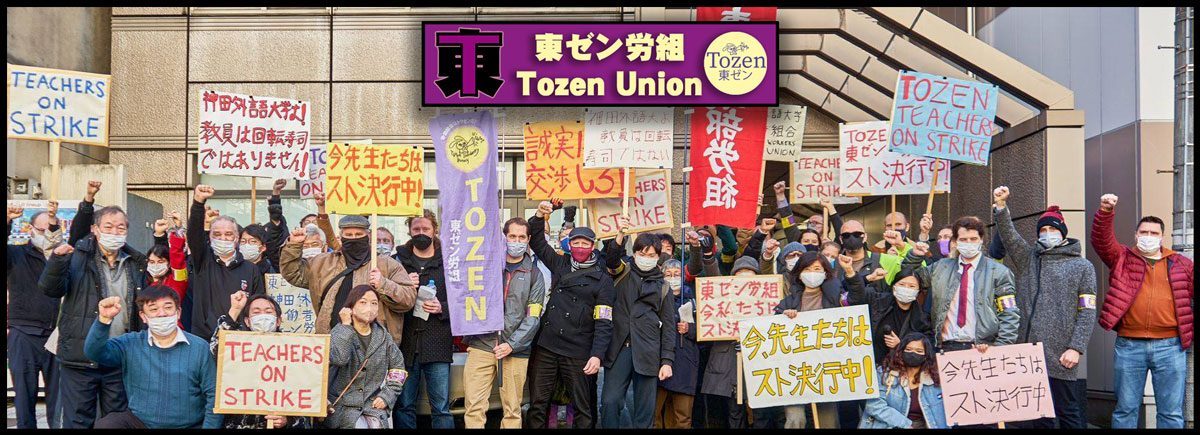*Know your rights – Part two:
Unemployment Insurance (雇用保険 — こようほけん)
You must be enrolled in Unemployment Insurance if you:
If you work over 20 hours per week there is a high possibility that you must be enrolled in this insurance. Contact the union office if you think you should be enrolled.
Once you are enrolled, your premiums are 0.8% of your gross income.The main unemployment allowances are:
Basic Allowance (Kihon Teate)
In case of unemployment, to enable the unemployed seek stable employment. According to the worker’s age and years of service, 50-80 percent (%) of his/her average daily wage will be provided for 90 to 300 days.
Technical Skill Learning Allowance (Gino Shutoku Teate)
Allowance provided for the learning of technical skills by the unemployed. To undertake training, permission (a public occupation training order) must be received from the public employment offices’ general manager.
Lodging Allowance (Kishuku Teate)
Provided when it is necessary for the unemployed to live independently from their supporting family to undertake job training.
Injury/Sickness Allowance (Shobyo Teate)
Provided instead of a basic allowance when the unemployed is unable to take a job due to injury or illness after having applied for work through the public employment office.
Job Starters’ Allowance (Saishushoku Teate)
Provided when the unemployed finds stable employment at an early stage of receiving the Basic Allowance. Note that certain requirements must be met.
Education and Training Allowance (Kyoiku Kunren Kyufukin)
Provided to increase labor skills, under certain conditions 40 percent of the cost of education and training can be provided. (max. 200,000)
Childcare Leave Basic Allowance (Ikuji Kyugyo Kihon Kyufukin)Provided to enable the employee to take leave from work in order to take care of a child aged under 12 months.
Nursing Leave Allowance (Roujin Kaigo Teate)Provided to enable an employee to take leave from work in order to care of a family member of members.
Application Procedure For Basic Allowance
Get a “letter of separation” (rishokuhyo) from your company. This will detail the period for which you have participated in unemployment insurance, your wages, and the reason for leaving your job. You take the letter of separation to your local public employment security office and once you have applied to search for work, you may receive acknowledgment of your unemployed status. You should keep in mind that if you choose to quit your company you might have to wait for between one and three months before receiving any allowance. How long you can receive the allowance for depends on your age and how long you have participated in the system, but it varies as below.
Unemployment Benefit AllowanceA= Voluntary Resignation or Retirement |
||||||
| Age | Enrollment Status | Length of Employment determines Duration of Allowance in Days |
||||
| less than 1 year | 1 – 4 years | 5 – 9 years | 10 – 19 years | more than 20 years | ||
| 29 or less | A B |
90 90 |
90 90 |
120 120 |
150 180 |
– – |
| 30 to 44 | A B |
90 90 |
90 90 |
120 180 |
150 210 |
180 240 |
| 45 to 59 | A B |
90 90 |
90 180 |
120 240 |
150 270 |
180 330 |
| 60 to 64 | A B |
90 90 |
90 150 |
120 180 |
150 210 |
180 240 |
NOTE: The new system no longer makes a classification based on the category a worker is enrolled in. The two major changes that commenced from October 1, 2007 are:
1. Workers enrolled as “part-time” insured workers will be eligible to receive unemployment benefits sooner in the case of dismissal or corporate layoffs. To qualify they will need to have worked 11 days or more, for 6 months or more, in a 12 month period prior to the date of separation.
2. When ceasing employment voluntarily all insured workers will now need to have worked 11 days or more, for 12 months in a 2 year period prior to the date of separation to qualify for unemployment benefits.
Eligibility criteria does change, the above information is a guide only. For further detailed information concerning eligibility contact the Hello work office in your area.
Paid Holidays – Know your rights (Part 1)
Health and Pension Insurance – Know your rights (Part 3)
